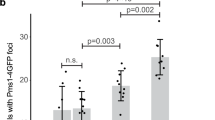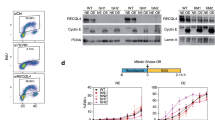Abstract
NUCLEOTIDE-excision repair (NER)1 is an important cellular defence mechanism against mutagenesis and carcinogenesis. The essential yeast genes RAD3 (ref. 2) and SSL2 (RAD25) 3,4, homologues of the human xeroderma pigmentosum genes XPD) 5,6 and XPB7 respectively, have been implicated in NER in yeast. The products of these genes are also subunits of (Rad3 protein) or associate with (Ssl2 protein) purified yeast RNA polymerase II transcription initiation factor b, the counterpart of human TFIIH8. Rad3 and Ssl2 proteins may participate directly in NER. Alternatively, they may function exclusively as transcription factors that support NER by influencing the expression of other NER genes. Here we show that defective NER in rad3 mutant extracts can be specifically complemented by purified transcription factor b. Similarly, defective NER in ssl2 mutant extracts is corrected by purified factor b/Ss12 complex. These results support a direct role of factor b during NER in yeast. Hence, factor b (TFIIH) has a dual role in transcription and NER.
This is a preview of subscription content, access via your institution
Access options
Subscribe to this journal
Receive 51 print issues and online access
$199.00 per year
only $3.90 per issue
Buy this article
- Purchase on Springer Link
- Instant access to full article PDF
Prices may be subject to local taxes which are calculated during checkout
Similar content being viewed by others
References
Friedberg, E. C. DNA Repair (Freeman, New York, 1985).
Friedberg, E. C., Siede, W. & Cooper, A. J. in The Molecular and Cellular Biology of the Yeast Saccharomyces: Genome Dynamics, Protein Synthesis, and Energetics, vol. 1 (eds Broach, J. R., Jones, E. & Pringle, J.), 147–192 (Cold Spring Harbor Laboratory Press, Plainview, New York, 1991).
Gulyas, K. D. & Donahue, T. F. Cell 69, 1031–1042 (1992).
Park, E. et al. Proc. natn. Acad. Sci. U.S.A. 89, 11416–11420 (1992).
Weeda, G. et al. Cell 62, 777–791 (1990).
Flejter, W. L., McDaniel, L. D., Johns, D., Friedberg, E. C. & Schultz, R. A. Proc. natn. Acad. Sci. U.S.A. 89, 261–265 (1992).
van Duin, M. et al. Cell 44, 913–923 (1986).
Feaver, W. J. et al. Cell 75, 1379–1387 (1993).
Wang, Z., Wu, X. & Friedberg, E. C. Proc. natn. Acad. Sci. U.S.A. 90, 4907–1911 (1993).
Fuchs, R. P. P. & Seeberg, E. EMBO J. 3, 757–760 (1984).
Sancar, A., Franklin, A., Sancar, G. B. & Tang, M. S. J. molec. Biol. 184, 725–734 (1985).
Hansson, J., Munn, M., Rupp, W. D., Kahn, R. & Wood, R. D. J. biol. Chem. 264, 21788–21792 (1989).
Szymkowski, D. E., Yarema, K., Essigman, J. M., Lippard, S. J. & Wood, R. D. Proc. natn. Acad. Sci. U.S.A. 89, 10772–10776 (1992).
Sweder, K. E. & Hanawalt, P. C. J. biol. Chem. 269, 1852–1857 (1994).
Guzder, S. N. et al. Nature 367, 91–94 (1994).
Qui, H., Park, E., Prakash, L. & Prakash, S. Genes Dev. 7, 2161–2171 (1993).
Gileadi, O., Feaver, W. J. & Kornberg, R. D. Science 257, 1389–1392 (1992).
Yoon, H., Miller, S. P., Pabich, E. K. & Donahue, T. F. Genes Dev. 6, 2463–2477 (1992).
Terleth, C., van de Putte, P. & Brouwer, J. Mutagenesis 6, 103–111 (1991).
Hanawalt, P. & Mellon, I. Curr Biol. 3, 67–69 (1993).
Downes, C. S., Ryan, A. J. & Johnson, R. T. BioEssays 15, 209–216 (1993).
Wang, Z., Wu, X. & Friedberg, E. C. Biochemistry 31, 3694–3702 (1992).
Naumovski, L. & Friedberg, E. C. Molec. cell. Biol. 6, 1218–1227 (1986).
Morrison, A. et al. J. Bact. 171, 5659–5667 (1989).
Wang, Z., Wu, X. & Friedberg, E. C. J. biol. Chem. 266, 22472–22478 (1991).
Naegeli, H., Bardwell, L. & Friedberg, E. C. J. biol. Chem. 267, 392–398 (1992).
Bardwell, L. et al. Proc. natn. Acad. Sci. U.S.A. (in the press).
Author information
Authors and Affiliations
Rights and permissions
About this article
Cite this article
Wang, Z., Svejstrup, J., Feaver, W. et al. Transcription factor b (TFIIH) is required during nucleotide-excision repair in yeast. Nature 368, 74–76 (1994). https://doi.org/10.1038/368074a0
Received:
Accepted:
Issue Date:
DOI: https://doi.org/10.1038/368074a0
This article is cited by
-
TFIIE orchestrates the recruitment of the TFIIH kinase module at promoter before release during transcription
Nature Communications (2019)
-
Regulation of translocation polarity by helicase domain 1 in SF2B helicases
The EMBO Journal (2012)
-
Hepatitis B virus X protein impedes the DNA repair via its association with transcription factor, TFIIH
BMC Microbiology (2011)
-
Mechanisms of transcription-coupled DNA repair
Nature Reviews Molecular Cell Biology (2002)
-
Structural and functional involvement of p53 in BER in vitro and in vivo
Oncogene (2001)
Comments
By submitting a comment you agree to abide by our Terms and Community Guidelines. If you find something abusive or that does not comply with our terms or guidelines please flag it as inappropriate.



